In reality, the hygiene of raincoats is an issue that many users have yet to truly consider and understand.
Most people believe that after using a raincoat, simply drying it and putting it away is sufficient. However, in practice, neglecting this can lead to unpleasant odors over time, or more seriously, bacteria infiltrating and inadvertently affecting the life and health of the raincoat users.

It is best to clean the raincoat after use instead of just drying it. (Illustrative image)
Therefore, it is advisable that after each rain exposure, especially during heavy downpours, users should make an effort to wash their raincoats. For light rain, assess the wetness of the raincoat and then clean it accordingly.
So, can raincoats be machine washed? Should they be washed in hot or cold water? Below are expert tips.
Steps for Washing Raincoats Effectively
Washing raincoats can be done simply in two ways: by hand or by machine, without taking much time from the user. However, there are specific points to note to ensure that the raincoat is not only washed clean but also maintains its durability and effectiveness. Regarding water temperature, users should use cold or lukewarm water. Hot water is not recommended.
Along with water temperature, there are many other considerations and specific steps to follow. Below is a suggestion from the expert site WikiHow, including the procedures to follow before washing, during washing, and after washing.
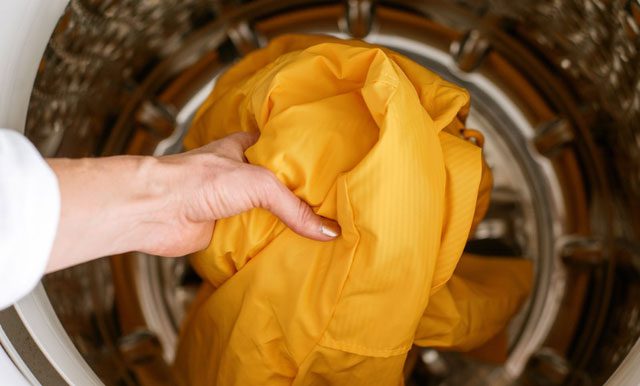
Raincoats can be washed in a washing machine and should be washed in cold water. (Illustrative image)
1. Before Washing
Before washing the raincoat, particularly for full rain suits with pockets in the pants and jacket, users need to carefully check these pockets for any stray items. Objects left in the pockets can hinder the washing process and reduce cleaning effectiveness.
Full rain suits often have buttons and zippers. Ensure that buttons are fastened or zippers are closed. If there are elastic bands or ties at the hood or collar, they should also be secured.
Raincoats worn outdoors will inevitably collect dust, debris, and leaves. Therefore, before washing, users should use a cloth or tissue to remove these contaminants. A better method is to use a brush to gently scrub the coat in a circular motion. Once most dirt is removed, the raincoat will be ready to wash.
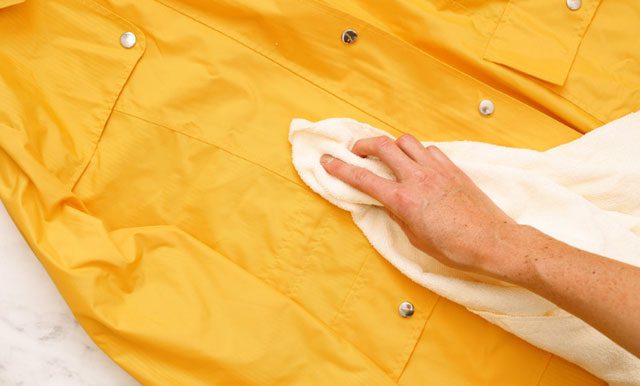
Once most dirt is removed, the raincoat is ready to be washed. (Illustrative image).
2. While Washing
Hand Washing
For hand washing, the first step is to rinse the raincoat with cold water. This step is crucial, as failing to do so may result in the raincoat not being thoroughly cleaned.
Next, spread the raincoat out on the floor. The cleaning solution for hand washing will be a mixture of detergent and water. Pour this mixture directly onto the surface of the raincoat and scrub evenly with a brush or sponge.
The raincoat has two sides; therefore, scrub both the inside and outside to completely eliminate bacteria that cause unpleasant odors. If mold appears on the raincoat and cannot be cleaned with regular detergent and water, use vinegar or rice wine.
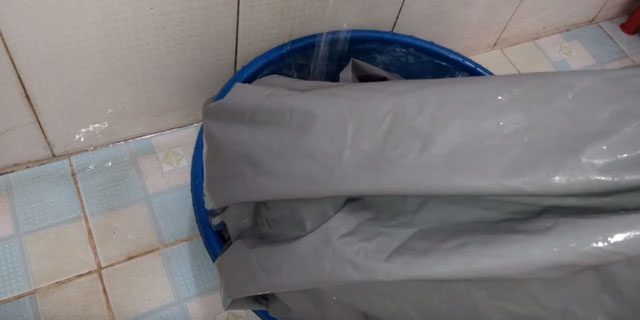
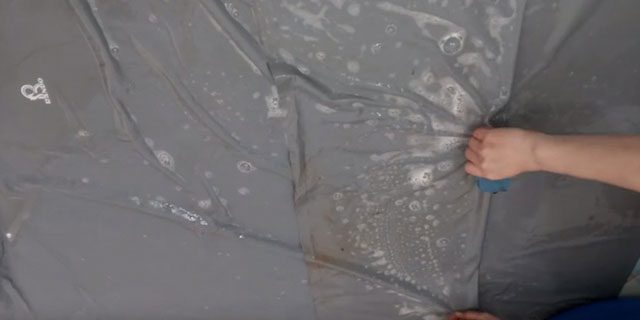
The raincoat has two sides, so scrub both the inside and outside. (Illustrative image).
To do this, soak a cloth or sponge in vinegar or rice wine, and then scrub vigorously on the moldy areas. The acid will help eliminate the mold quickly.
Finally, rinse the raincoat with clean water and hang it to dry.
Machine Washing
Because it is a specialized garment, it is best to wash the raincoat separately in the washing machine, not with other clothes.
Next, pay attention to choosing an appropriate detergent when washing the raincoat in a washing machine. Experts note that some strong chemical detergents can damage the waterproof coating of the raincoat. The detergent drawer should also be cleaned to avoid any leftover residues that could adhere to the coat, causing wear and tear.
Then, instead of selecting a deep wash or heavy cycle, users should choose the gentlest cycle to ensure the raincoat is not torn or its waterproof coating damaged during the washing process.
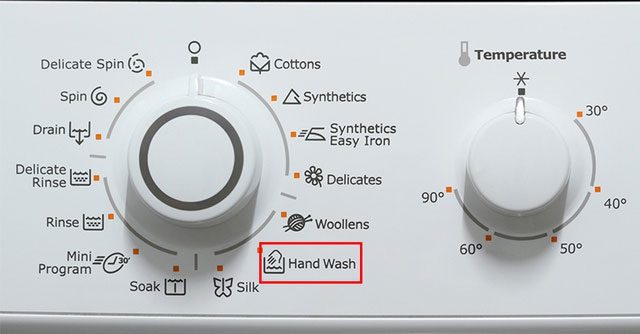
Users should only choose the gentle wash setting when washing raincoats in a washing machine. (Illustrative image).
Typically, one wash cycle is enough to clean the raincoat adequately. However, for extra assurance, users can run an additional rinse cycle to thoroughly remove detergent and prevent residue from sticking to the raincoat. Finally, remove the raincoat from the washing machine and hang it to dry.
For those who need their raincoats to dry quickly and consider using drying settings, carefully check the labels and instructions on the raincoat packaging to ensure compatibility.
Another useful tip from WikiHow is to help the raincoat dry faster. This involves spreading the raincoat out or hanging it on large hooks. Check to see if one side of the raincoat is dry, then flip it over to allow even drying.

Spreading the raincoat out or hanging it on large hooks helps it dry faster. (Illustrative image).
For some types of raincoats, after prolonged use, the waterproof coating may wear off. Users can check this issue as follows:
- Sprinkle water on the surface when the raincoat is dry.
- If the droplets remain after a few minutes, the waterproofing is still effective.
- However, if the water does not form droplets and soaks in quickly, it means the waterproof layer has worn off.
When returning from the rain, if you do not have time to wash the raincoat immediately, you can rinse it with water. This action can help remove mold and unpleasant odors from the coat.




















































